- Home
- Jennifer Niven
The Aqua Net Diaries: Big Hair, Big Dreams, Small Town
The Aqua Net Diaries: Big Hair, Big Dreams, Small Town Read online
THE
AQUA NET
DIARIES
Big Hair, Big Dreams,
Small Town
THE
AQUA NET
DIARIES
Big Hair, Big Dreams,
Small Town
JENNIFER NIVEN
Photo credits: pp. 1, 9, 159, 206 © WayNet.org; pp. 17, 102, 144, 152, 226 courtesy of Jeff Shirazi; pp. 22, 41 courtesy of Jack F. McJunkin Jr.; pp. 29, 36, 45, 108, 183, 255, 264 courtesy of the Richmond High School Pierian; pp. 46, 58, 70, 114, 131 courtesy of Penelope Niven; pp. 53, 91, 94, 120, 167, 277 courtesy of the author; p. 81 courtesy of Beth Jennings-White; p. 127 courtesy of Laura Lonigro; pp. 137, 174, 235, 293 (left), 295 (left), 299, 303, 305, 307 courtesy of Pyle Photography; p. 194 reprinted with permission from the Palladium-Item, Richmond, Ind.; pp. 215, 238 courtesy of Aldo Lonigro; p. 248 courtesy of Olan Mills Portrait Studio; p. 272 courtesy of Rebecca Scheele; pp. 290–91 courtesy of Wahlberg Panoramic Photography; p. 293 (right) courtesy of Stephen Hunton; p. 295 (right) courtesy of Steve Kunken; pp. 297, 301 courtesy of David Geier Photography; p. 309 courtesy of John Hreno III
Gallery Books
A Division of Simon & Schuster, Inc.
1230 Avenue of the Americas
New York, NY 10020
www.SimonandSchuster.com
Copyright © 2009 by Jennifer Niven
All rights reserved, including the right to reproduce this book or portions thereof in any form whatsoever. For information address Pocket Books Subsidiary Rights Department, 1230 Avenue of the Americas, New York, NY 10020.
First Gallery trade paperback edition February 2010
GALLERY and colophon are trademarks of Simon & Schuster, Inc.
For information about special discounts for bulk purchases, please contact Simon & Schuster Special Sales at 1-866-506-1949 or [email protected].
The Simon & Schuster Speakers Bureau can bring authors to your live event. For more information or to book an event, contact the Simon & Schuster Speakers Bureau at 1-866-248-3049 or visit our website at www.simonspeakers.com.
Designed by Nancy Singer, Class of 1979
Illustrated by Alexandra Davis Ivey, Class of 2012
Manufactured in the United States of America
10 9 8 7 6 5 4 3 2 1
Library of Congress Cataloging-in-Publication Data
Niven, Jennifer.
The aqua net diaries : big hair, big dreams, small town / Jennifer Niven.
p. cm.
1. Richmond High School (Richmond, Ind.)—History. 2. Niven, Jennifer—Childhood and youth. 3. High school students—Indiana—Richmond—Social life and customs.
I. Title.
LD7501.R462N48 2009
373.772’63—dc22 2009017453
[B]
ISBN 978-1-4169-5429-3
ISBN 978-1-4169-5920-5 (eBook)
for Joey—
best friend forever
In so many ways,
the story couldn’t have been
written without you
And for Richmond, Indiana,
my hometown
American girl,
American boy,
Living in a small town.
Dreaming of the great big world
And all that lies beyond …
—“Back Again in Richmond,”
original song by
Jennifer McJunkin & Joey Kraemer
Contents
High School Is (Almost) the Same Everywhere
ORIENTATION
America’s Main Street
STUDENT LIFE—PART ONE
Cheerleaders
Driver’s Ed
Best Friends
The Social Order
Why I Hate Girls
What’s Out/What’s In
Dress Code
Cafeteria Rules
First Love
The Telephone
ACADEMICS
Algebra
World Affairs
Typing
Our Good Health and Safety
Teachers
How I Spent My Summer
Snow Days
STUDENT LIFE—PART TWO
Show-and-Tell
A Dance Is Just a Dance
Survival
Law and Order
Politics
Signs
First Heartbreak
Older Men
ACTIVITIES
King and Queen of the World
Triumphs and Tragedies
Community Outreach
Experimental Writers Group
The Business of Drinking
COMMENCEMENT
The Rules of Senior Poker
Submissions
Homework
Prom
Castles in the Air
Graduation Party
(ON THE WAY TO) THE REAL WORLD
The Last Party
ALUMNI
School Portraits
Extra Credit
Q & A with Jennifer Niven McJunkin
For the Reader …
I keep everything, and that includes every high school note I ever wrote and every note that was ever written to me (and believe me, there were a lot of them). If I quote a note in this book, it’s an actual note from high school written during a class when I was supposed to be paying attention. I have also kept every partially written journal, every notebook, every high school drama program, sports ticket, photo, school paper, newspaper, story, poem, play, song (or any other type of creative anything I may have written), and every audiotape I ever made. Keeping these things was something I did with the intention of helping out my biographers one day, back in Indiana with my big dreams about becoming an Oscar-winning actress, international rock star, and Pulitzer Prize–winning writer. Little did I know how useful they would be to me when writing my own story.
Many of the names here are real. Some have been changed. Everything that happened is true as I remember it.
Richmond High School
High School Is (Almost) the Same Everywhere
Special times and special places
Special friends together;
The moments pass so quickly,
But the memories last forever.
—Motto, Richmond High School,
class of 1986
If you had found me in 1986, walking down the halls of Richmond High School in Richmond, Indiana, and said to me, “One day, someone will pay you to write a book about your years going to school here, and people will actually want to read it once it comes out,” I would have said, “I’m sorry, I think you have me mixed up with someone who lives in a much bigger and more interesting place. There is absolutely nothing to write about except how much I can’t wait for high school to be over.” Then I would have laughed and laughed and written notes to all my very best friends (during class, of course) saying, Can you believe this? People are crazy!
The very thing that distinguished my high school experience to me back then was that it was undistinguishable. To my teenage mind, it was dull, interminable, and I couldn’t wait for it to be over. It wasn’t that I didn’t have fun or friends or enjoy myself, I just didn’t see anything exceptional about it while I was living it. Not like my mother’s experience—she was the one with the stories. She grew up in a charming town the size of a postage stamp in North Carolina, which was already more charming than Indiana because everybody had accents. Everyone knew everyone else and, yes, they were bored, too, but they made their own fun. In addition, she grew up in the 1950s—a decade with style and glamour. I grew up in the 1980s. We listened to Prince an
d Madonna and to hair bands. Our own hair was enormous. We wore parachute pants and Peter Pan boots and Swatches all the way up our arms. There was nothing charming about it.
My best friend Joe Kraemer (whom I met in tenth grade) was invited to a Halloween party a couple of years ago where the theme was Come as Your Worst Nightmare. He thought of every scary monster through the history of time, before concluding that his actual worst nightmare was himself in high school, right down to the big hair and oversized glasses and desperate need to fit in.
So this book came about by accident. It was never something I intended to write. If anything, I only wanted to leave high school far, far behind me—forever.
• • •
The idea for the book came about when I traveled to Russia in 2005. It was there I met Anya, who was sixteen. She was living in the tiny village of Novoye Chaplino, which is nestled along the eastern coast of Siberia. The village is populated by three hundred Siberian Yupik and a small number of Slavic Russians and Chukchi. Chaplino was once a thriving little whaling village with a whale processing factory, which now sits in ruins. Whale bones littered the ground, which was dotted here and there by wildflowers. Sled dogs wandered the dirt streets of the village, scavenging for food. Chaplino is void of trees and surrounded by Tkachen Bay—part of Senyavin Strait—and soaring mountains. The only road comes from the neighboring village of Providenia. Every few months, someone arrives by boat or by ship, as we did—aboard an icebreaker with Quark Expeditions. Otherwise the people of Chaplino are cut off from the world.
There is a school in the middle of the village that also serves as the town gathering place. The villagers invited us there for a show, and offered us whale blubber and hot tea as we sat on bleachers and watched schoolchildren, ages six through eighteen, perform traditional dances and athletic demonstrations. Anya was one of the best dancers.
Afterward, I asked her about what it was like to grow up in Chaplino. As far as I could see, you could not find a place more different from Richmond, Indiana, with its farms and tractors and Trans Ams and mullets and food festivals and sports, sports, sports all the time.
“It is sometimes so quiet,” Anya said, and she laughed. “Here we are all in one school, even the young ones. A lot is expected. I wish sometimes there were new boys because we know the old ones so well.” As she talked, she glanced now and then at a tall boy in a blue hooded shirt. He had black hair and was one of the athletic performers. “There is nothing to do, and we are bored in class. I am good at dancing but I am terrible at English. I do not like math.” She laughed again. “It is hard sometimes to feel good about yourself because others”—she nodded at three girls standing across the gym—“like to say things behind your back. This is not fair, but there is nothing you can do to keep them from talking. I dream of going to Moscow one day after graduation. I think it might be better there.”
Anya wanted to know what high school was like in America. “It must be very different,” she said.
I thought before I answered her that, for me, high school was dating Eric Lundquist and Alex Delaney, flirting with Tommy Wissel, and wishing Dean Waldemar had asked me out. It was parties at Teresa Ripperger’s and Eric Ruger’s, and feeling snubbed by the cheerleaders. It was hating algebra and geometry and all things math, competing in speech meets, and wanting desperately to get excused from P.E. It was spending the weekends with my best friend Joey and with my other friends, trying to think of something fun or interesting to do. It was dreaming of the day I would graduate and be released from my school and my town.
“Actually,” I said to Anya, “I think high school is really much the same everywhere.”
When I returned to the States, I thought, I’ll write a fat comprehensive book on high school—on its history and its origins. I started researching and writing, and all the research and writing put me to sleep. I fell right over onto my laptop. To keep myself awake, I decided to illustrate some of the history with funny stories from my own high school experience—crazy little adventures that I’d had, that my friends and I had lived through. What came out on the page were stories of a simpler time and place—funny, poignant, silly tales about a girl who never felt quite at home (but wanted to) in the enormous lone high school in her small Indiana town, about a rare friendship, about an eventual loss of innocence, and about some very big dreams. And this, not the dry and boring history book, was the story I ultimately found myself wanting to tell.
When I told my classmates what I was doing, they said, “Seriously? And someone is paying you?” And they began to laugh, just like I would have if I had been them.
I said, “Yes, and I want you to be characters.”
They quickly stopped laughing. “With our real names?”
“Yes.”
“What stories will you be including?”
“Only the interesting ones,” I said, which made them wonder if I should use their real names after all (eventually—remarkably—many of them decided it was okay).
The most extraordinary thing about this journey is that I realized my mom isn’t the only one with a charming story to tell. The more I wrote—and wrote and wrote—the more I realized what a special time high school was for me, too. I went to high school in America’s heartland, in a pre-9/11 world. Nothing bad had happened to me yet. Everyone I’d ever known was still alive and happy. My parents were still married, although I didn’t know yet that they were on the brink of separation. Life was innocent, good. There was angst, but it mostly involved having a bad hair day, finding the next party, worrying about saying and doing the right thing, wrestling with geometric theorems, trying not to die of boredom, and wanting to be noticed by the one boy we all loved more than anything. It was a time when we were fearless and invincible, when all our firsts were still ahead of us—first time behind the wheel of a car, first date, first love, first heartbreak, first drink, first job, first vote, first time leaving home to go out into the great big world. It was a time when anything was possible.
This is the story of one girl’s high school experience. Some of it is universal and some of it belongs just to me, but in it, I hope you will find some of your own experiences, and some of yourself—the self you were then, the self you’ve become.
Orientation
During a record-breaking heat wave, RHS students obediently ended their summer vacations and wended their way back to stuffy classrooms and halls, almost ready to start another year of listening, studying, learning, and socializing. For some of us, it was our first time ever at the high school, and that in itself was terrifying but exciting. There was so much ahead of us, and we could feel it in the air. What would happen to us there? We were about to discover why they call these the best years of our lives.
Downtown Richmond; Richmond on a map; one of Richmond’s many festivals
America’s Main Street
Indiana … is a garden
Where seeds of peace have grown,
Where each tree, and vine, and flower
Has a beauty … all its own.
—Arthur Franklin Mapes, “Indiana” (state poem)
When I was growing up, there were 36,000 people living in Richmond, Indiana—a fact I always found astonishing because, for me, the town consisted of: my parents; my neighborhood playmates; and the people I went to school with, namely my best friend Joey; my next best friends (a constantly revolving group); any boy I happened to be dating at the time; the popular crowd (of which I was a sometime member); and Tom Dehner, the boy we all admired. My Richmond felt much smaller than 36,000 people. In fact, I wondered where the rest of them were.
We moved to Richmond from Maryland in 1977, when I was entering the fourth grade. When my mother told her mother—also born and raised in a tiny North Carolina town—that we were moving to Indiana, Grandmama said, “Why on earth do you want to do a thing like that? Nobody moves to Indiana.”
I had to agree with her. At first sight, I thought Indiana was the ugliest place I had ever seen. “Just rem
ember,” my mother told me, “what is ugly to you is beautiful to some people.” As we crossed the state line from Ohio into Indiana, I looked out the window of our white Ford Pinto at cornfield after cornfield. At one point, there was an actual tractor driving down the road. A tractor! And I thought how wrong my mother was. I couldn’t imagine anyone thinking Indiana was beautiful.
Our first week there, we experienced our first tornado. Clouds gathered and the sky turned green over the roof of the house we were renting until we could find one to buy (maybe this would change my parents’ minds, I thought, praying for the tornado to come and not kill us but maybe do enough damage to scare them into leaving). There was wind and rain and the sky got greener and greener and I thought God Himself was probably showing his own displeasure at my parents’ decision to move us to the Midwest. My mom and I, and our two cats and dog, buried ourselves under blankets and pillows while my dad slept right through it and never even woke up.
The next day we emerged from the storm just fine, without any damage to the house or our car or ourselves. My father was even well rested. But the cats had had all they could stand. Princess and her sister Michael (named for Michael Jackson, one of my first true loves) managed to unlatch a screen in a second-floor window and set themselves free. Together they set off down the Great National Road—the nation’s first highway, otherwise known as America’s Main Street—past Earlham College, past Cox’s Grocery, past Miller’s Milk House and the gun store, racing east toward freedom and home until my father, by some miracle, chased them down and brought them back.
Before I even unpacked, the first thing I did after we moved into our new house at 720 Hidden Valley Drive was to sit on the green-carpeted floor of my new bedroom and write a story. I illustrated it myself with pictures of a moving truck and cornfields and a girl with long brown hair and a sad face. It was called “My Life in Indiana: I Will Never Be Happy Again.” After I finished, I took it downstairs to my parents and handed it to them. I didn’t say anything, just placed it in my mother’s hands, waited till she and my dad had read the title page, and then turned around and left the room.

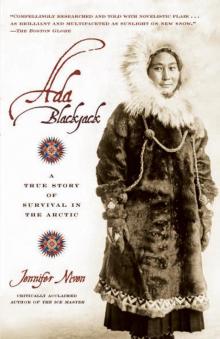 Ada Blackjack: A True Story of Survival in the Arctic
Ada Blackjack: A True Story of Survival in the Arctic The Aqua Net Diaries: Big Hair, Big Dreams, Small Town
The Aqua Net Diaries: Big Hair, Big Dreams, Small Town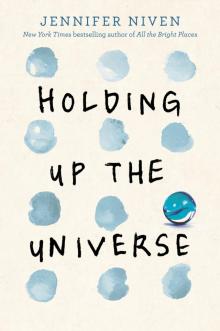 Holding Up the Universe
Holding Up the Universe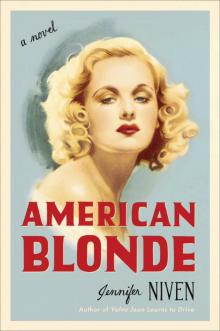 American Blonde
American Blonde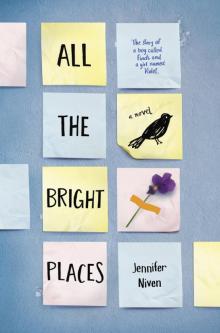 All the Bright Places
All the Bright Places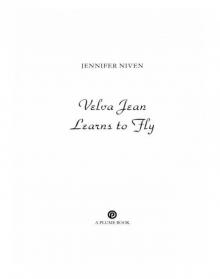 Velva Jean Learns to Fly
Velva Jean Learns to Fly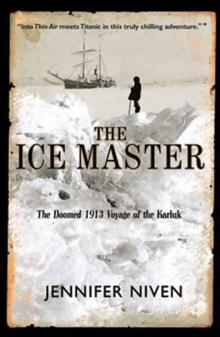 The Ice Master
The Ice Master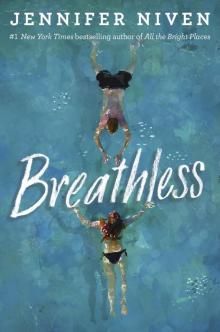 Breathless
Breathless The Aqua Net Diaries
The Aqua Net Diaries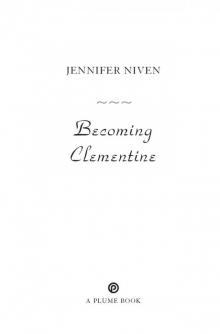 Becoming Clementine: A Novel
Becoming Clementine: A Novel